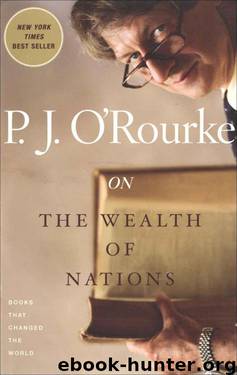On the Wealth of Nations: Books That Changed the World by P.J. O'Rourke

Author:P.J. O'Rourke [O'Rourke, P.J.]
Language: eng
Format: epub
ISBN: 0802143423
Publisher: Grove Press
Published: 2007-12-20T23:00:00+00:00
CHAPTER 9
The Wealth of Nations, Book 4, Continued
Adam Smith versus the Ideological Swine When They Were Still Cute, Squealing Piglets
The mercantilists were not Adam Smith’s only target. Book 4 of Wealth also presents a polite (but not very) attack on the French physiocrats. Smith was friends with members of the physiocratic school. He admired their founder, court physician François Quesnay, enough that it was his intention to dedicate The Wealth of Nations to him. But Quesnay died shortly before publication. Maybe it was just as well, considering what was said about the physiocrats in Wealth. Smith also respected the abilities of Quesnay’s two most prominent disciples, Anne-Robert-Jacques Turgot, who was Louis XVI’s comptroller of finances, and Pierre-Samuel Du Pont de Nemours, who became an economic advisor to the French revolutionary government until he was denounced for being insufficiently radical.
The principles of the physiocrats were so insufficiently radical that, on first hearing, they sound like those of country club Republicans or provincial Tories. The physiocrats believed in private property, minimal government, and bureaucratic noninterference. A precursor to the physiocrats, Vincent de Gournay—whom they regarded as a sort of John the Baptist of their thinking—coined the term laissez-faire. The physiocrats respected the law. When Louis XVI was the dauphin, Quesnay advised him that, upon becoming king, he should “do nothing, but let the laws rule.” It was sad advice considering the laws the Jacobins would pass. But, then again, the physiocrats always were skeptical about popular democracy.
The physiocrats referred to themselves as economists and were the first students of economy to claim that honorific. Until then economist meant someone who was good at scrimping and saving. The physiocrats were also the first to formulate a coherent economic theory. Adam Smith agreed with all the economic deductions the physiocrats made. He agreed with everything concerning their theory, except the theory.
The physiocrats applied far too much power of ratiocination to the concepts of “productive” and “unproductive” labor. The distinction between the two was silly enough in Adam Smith’s later and more measured analysis, but the physiocrats were obsessed with the subject. They convinced themselves that, as Smith summarized it, “The labour of artificers and manufacturers never adds any thing to the value of the whole annual amount of the rude produce of the land,” and “Mercantile stock is equally barren and unproductive.”1 For increasing the wealth of a nation, farming was all that mattered. However, the physiocrats decided that mining was helpful, too. So they made mining a part of farming, as if French peasants digging turnips could just dig a little deeper and get iron ore and coal.
To the physiocrats, occupations other than farming were considered “sterile” and yet, at the same time, “useful.” They did not propose to restrict trade or manufacturing. The physiocrats held that, again in Smith’s words, “It can never be the interest of the proprietors and cultivators to restrain or to discourage in any respect the industry of merchants, artificers and manufacturers.”2 So the physiocrats recognized the importance of trade and manufacturing, but didn’t recognize it.
Download
This site does not store any files on its server. We only index and link to content provided by other sites. Please contact the content providers to delete copyright contents if any and email us, we'll remove relevant links or contents immediately.
International Integration of the Brazilian Economy by Elias C. Grivoyannis(86488)
The Radium Girls by Kate Moore(11867)
Turbulence by E. J. Noyes(7895)
Nudge - Improving Decisions about Health, Wealth, and Happiness by Thaler Sunstein(7460)
The Black Swan by Nassim Nicholas Taleb(6948)
Rich Dad Poor Dad by Robert T. Kiyosaki(6318)
Pioneering Portfolio Management by David F. Swensen(6169)
Man-made Catastrophes and Risk Information Concealment by Dmitry Chernov & Didier Sornette(5878)
Zero to One by Peter Thiel(5638)
Secrecy World by Jake Bernstein(4594)
Millionaire: The Philanderer, Gambler, and Duelist Who Invented Modern Finance by Janet Gleeson(4300)
Skin in the Game by Nassim Nicholas Taleb(4123)
The Age of Surveillance Capitalism by Shoshana Zuboff(4118)
The Money Culture by Michael Lewis(4026)
Bullshit Jobs by David Graeber(3993)
Skin in the Game: Hidden Asymmetries in Daily Life by Nassim Nicholas Taleb(3868)
The Dhandho Investor by Mohnish Pabrai(3636)
The Wisdom of Finance by Mihir Desai(3606)
Blockchain Basics by Daniel Drescher(3430)
